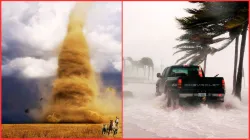Beryl: Confused about difference between tornadoes and hurricanes? Know here
NASA highlights the significant contrast between tornadoes and hurricanes primarily in their size: hurricanes cover a horizontal scale approximately a thousand times greater than tornadoes. Furthermore, they develop under unique conditions and have distinct influences on the atmosphere.

Hurricane Beryl broke numerous records even before its winds reached major hurricane strength near landfall. The formidable storm behaved akin to monsters typically seen during the peak of hurricane season, fueled largely by exceptionally warm water temperatures, matching or exceeding those typically observed in September for the region.
But, do you wonder what's the difference between a hurricane and a tornado?Both tornadoes and hurricanes exhibit powerful horizontal winds swirling around their centres, accompanied by a ring of strong upward motion surrounding downward motion within their cores. In both phenomena, the tangential wind speed far exceeds the speed of radial inflow or vertical motion. In the northern hemisphere, hurricanes consistently rotate counterclockwise, while tornadoes typically do so as well, although local wind conditions can occasionally induce clockwise rotation. The direction of rotation is dictated by the Earth's rotation in each hemisphere.
Still confused? Let's break down the details in simpler wordsAccording to NASA, the most noticeable distinction between tornadoes and hurricanes lies in their size: hurricanes span a horizontal scale about a thousand times larger than tornadoes. Moreover, they form under distinct circumstances and exert differing impacts on the atmosphere.
Tornadoes are small-scale circulations, often no more than a few hundred feet in diameter when they make ground contact. Many tornadoes originate from severe thunderstorms in the high wind-shear environment of the Central Plains in the United States during spring and early summer. These storms arise from clashes between moist, warm air travelling northward from the Gulf of Mexico and cold, dry continental air from the northwest United States. However, tornadoes can also develop in various other regions due to different forcing factors, such as hurricanes making landfall.
Wind speed: A major catalystA report by NASA claimed Tornado wind speeds can reach between 100 to 300 mph, causing significant ground havoc, but tornadoes typically last only minutes and travel relatively short distances of 10 to 20 miles. Their impact on the storms that generate them and on the global atmospheric circulation is minimal.
In contrast, hurricanes are large-scale circulations spanning 60 to over 1,000 miles in diameter. They form in tropical regions, generally between 5 and 20 degrees latitude, over warm ocean waters where temperatures exceed 26.5°C (76°F). Hurricanes can travel thousands of miles and persist for days or even weeks. Throughout their lifespan, they transport substantial amounts of heat from the ocean surface into the upper troposphere or lower stratosphere. Although hurricanes form sporadically, they significantly influence global atmospheric circulation, although the precise extent of this influence remains an active area of research.
What are the different categories or stages of a hurricane?
Hurricanes are classified into five categories based on their wind speeds, according to the Saffir-Simpson Hurricane Wind Scale:
- Category 1: Winds range from 75 to 95 mph
- Category 2: Winds range from 96 to 110 mph
- Category 3: Winds range from 111 to 129 mph
- Category 4: Winds range from 130 to 156 mph
- Category 5: Winds are 157 mph or higher
Also Read: VIDEO: From space to Barbados's sea beach, how catastrophic Hurricane Beryl looks